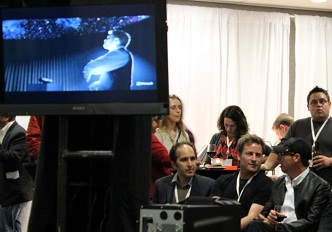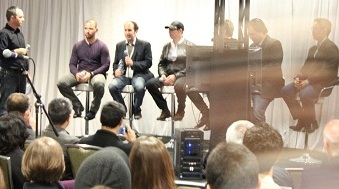The Past, Present, and Future of Multimodal Input Featured at Seattle Interactive Conference 2012
 Earlier this week at the 2012 Seattle Interactive Conference, Oscar Murillo, user experience architect for Kinect for Windows, kicked off a six-person panel discussion about the transformational power of voice and gesture technology with a demonstration that showed participants how much the Kinect sensor has grown beyond its gaming roots.
Earlier this week at the 2012 Seattle Interactive Conference, Oscar Murillo, user experience architect for Kinect for Windows, kicked off a six-person panel discussion about the transformational power of voice and gesture technology with a demonstration that showed participants how much the Kinect sensor has grown beyond its gaming roots.
"Kinect for Windows is a premier technology that enables users to interact with systems without touching a user interface" noted Murillo. "Human-to-human interactions are fluid and multimodal. With Kinect for Windows, we see human-computer interactions that are coming closer to mirroring the way humans naturally interact: effortless, transparent, and contextual communication between users and technology—by using voice and gesture—are now becoming possible. We see interactions that are as natural as human beings themselves."
Murillo illustrated how, by using Kinect for Windows, he can control an environment with his body and voice. The sensor changed his appearance and even placed him in different environments by using "real-time green screening" to provide a museum setting and an abstract landscape of cubes and spheres with which he could interact. Murillo tracked 100 different points on his face and showed both thermal and radiant scanning. The use of these and other emerging techniques provides "a novel way for users to interact with products, brands, environments, services, and each other," Murillo added.
 After Murillo’s presentation, Steve Clayton, editor of Next at Microsoft blog, moderated a panel of NUI thought leaders from around the world who are using Kinect for Windows in their work.
After Murillo’s presentation, Steve Clayton, editor of Next at Microsoft blog, moderated a panel of NUI thought leaders from around the world who are using Kinect for Windows in their work.
Academy Award-winning visual effects designer John Gaeta, who developed the "bullet time" effects in The Matrix Trilogy, also worked on Kinect for Windows in its early stages. His company, Float Hybrid Entertainment, develops interactive displays and participates in the Kinect for Windows advisory board.
"The thing that is interesting is the human interface part of it," observed Gaeta. "To allow people to have some sort of method to reflect themselves back, and that there can be a two-way relationship between the average person and a machine."
Scott Snibbe—founder of Snibbe Interactive and a world-renowned interactive media entrepreneur, researcher, and artist—is also an early pioneer with Kinect, which he has been working with since 2006. "With NUI, we can finally put the person in control of the computer instead of the computer controlling the person," he explained. "Humans are first and foremost social; Kinect for Windows can power social NUIs that respond to gesture and voice—the same way humans communicate with each other."
Matt Von Trott, digital director and partner at Assembly Ltd., noted the growing appeal of Kinect for Windows to the advertising industry. "In advertising these days, you need to make something that does more than make people talk about it," he said.
James Ashley, presentation layer architect on the Emerging Experiences team at the international digital agency Razorfish and a Microsoft Most Valued Professional for the Kinect sensor, remarked that he was skeptical the first time he saw the early concept videos for the project that eventually became Kinect for Windows. He didn’t believe it could really work. But it did, and the results were magical. "People want it and clients want it," he explained.
David Kung, vice president of business development at Oblong Industries, Inc. and former Disney Imagineer, notes that the bar for entry is much lower than with previous technological advances. "What's most exciting is how the developer community is adopting at a very low investment," he said. "Not just at a highly expensive R&D level."
"We still have a while to go before we get to true multi-modal—we are crawling still for sure," Kung added. "We can envision a time where technology could potentially answer a child's question while looking out the car window, 'What is that?' With NUI, GPS, and other advancements, such scenarios are possible."
This year's Seattle Interactive Conference (October 29 and 30) connected about 4,000 entrepreneurs, developers, and online business professionals who are all aspiring to explore the latest online technology and emerging trends. "We're straight-up geeks who just love technology, noted SIC co-founded Mark Peterson. “So, partnering with Microsoft and Kinect for Windows just made sense."
Kinect for Windows team
Key Links